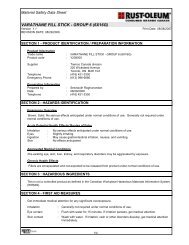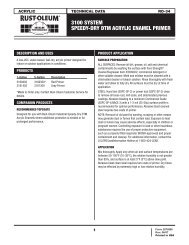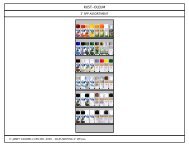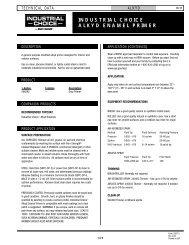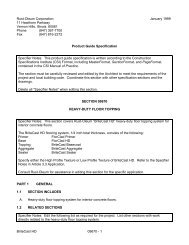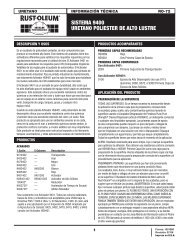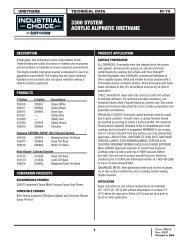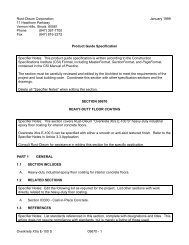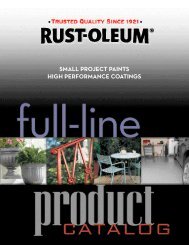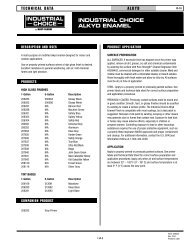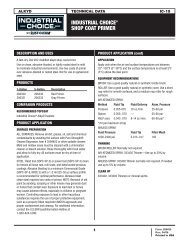HARD HAT UPSIDE DOWN WHITE 6x 510 GM - Rust-Oleum ...
HARD HAT UPSIDE DOWN WHITE 6x 510 GM - Rust-Oleum ...
HARD HAT UPSIDE DOWN WHITE 6x 510 GM - Rust-Oleum ...
You also want an ePaper? Increase the reach of your titles
YUMPU automatically turns print PDFs into web optimized ePapers that Google loves.
Material Safety Data Sheet<strong>HARD</strong> <strong>HAT</strong> <strong>UPSIDE</strong> <strong>DOWN</strong> <strong>WHITE</strong> <strong>6x</strong> <strong>510</strong> <strong>GM</strong>Version 1.1 Print Date 11/02/2006REVISION DATE: 08/29/2006SECTION 1 - PRODUCT IDENTIFICATION / PREPARATION INFORMATIONProduct InformationTrade name : <strong>HARD</strong> <strong>HAT</strong> <strong>UPSIDE</strong> <strong>DOWN</strong> <strong>WHITE</strong> <strong>6x</strong> <strong>510</strong> <strong>GM</strong>Product code : N2391 838Supplier : Tremco Canada division220 Wicksteed AvenueToronto, ON M4H 1G7Telephone : (416) 421-3300Emergency Phone: : (613) 996-6666Product use : CoatingPreparation InformationPrepared by: : Sewnauth RaghunandanDate: : 08/29/2006Telephone : (416) 421-3300SECTION 2 - HAZARDS IDENTIFICATIONEmergency OverviewWhite. Aerosol. May cause nausea, headaches, and dizziness. May cause drowsiness, weakness, and fatigue.Vapor and/or mist may irritate nose and throat. May cause moderate irritation to the respiratory system. Moveto fresh air. If required, artificial respiration or administration of oxygen can be performed by trained personnel.Acute Potential Health Effects/ Routes of EntryInhalation : May cause nausea, headaches, and dizziness. May cause drowsiness, weakness, andfatigue. Vapor and/or mist may irritate nose and throat. May cause moderate irritation tothe respiratory system.Eyes : Vapor and/or mist may cause eye irritation. Direct contact may cause temporary rednessand discomfort.Ingestion : May cause irritation to the mouth, throat and stomach. May cause gastrointestinalirritation, nausea, and vomiting.Skin : May cause mild irritation.Aggravated Medical ConditionsPre-existing eye, skin, liver, kidney, and respiratory disorders may be aggravated by exposure.Chronic Health EffectsPropellants in product, such as propane and isobutane, are asphyxiants and can be anesthetic at highconcentrations. Repeated overexposure to vapors and/or material may injure the liver, kidneys and respiratorysystem unless suitable engineering controls and/or personal protective equipment are used. Prolonged orrepeated exposure to xylene may cause defatting, drying, and irritation of the skin, dermatitis, central nervoussystem (CNS) effects, heart muscle sensitization and arrhythmia, hearing loss, and brain, liver, kidney damage.Xylene overexposure may affect fetal development. The International Agency for Research on Cancer (IARC)has evaluated ethylbenzene and classified it as a possible human carcinogen (Group 2B) based on sufficientevidence for carcinogenicity in experimental animals, but inadequate evidence for cancer in exposed humans.Prolonged or repeated exposure may cause defatting, drying, and irritation of the skin, dermatitis, centralnervous system (CNS) effects, heart muscle sensitization and arrhythmia, hearing loss, and brain, liver, kidney,and testes damage. Toluene overexposure may cause burns of the skin, respiratory tract damage. May be1/6
Material Safety Data Sheet<strong>HARD</strong> <strong>HAT</strong> <strong>UPSIDE</strong> <strong>DOWN</strong> <strong>WHITE</strong> <strong>6x</strong> <strong>510</strong> <strong>GM</strong>Version 1.1 Print Date 11/02/2006REVISION DATE: 08/29/2006harmful to the human fetus based on animal tests and limited epidemiology data. Overexposure to VM & Pnaphtha can cause central nervous system depression and anesthesia.Target Organs: Eyes., Skin.SECTION 3 : HAZARDOUS INGREDIENTSChemical Name CAS-No. Weight % RangeLiquified Petroleum Gas 68476-85-7 15.0 - 40.0Xylene 1330-20-7 15.0 - 40.0Toluene 108-88-3 15.0 - 40.0Ethylbenzene 100-41-4 3.0 - 7.0Aliphatic Naphtha 64742-89-8 3.0 - 7.0The ingredients listed above are hazardous as defined in the controlled products regulation. (CPR).SECTION 4 - FIRST AID MEASURESGet immediate medical attention for any significant overexposure.Inhalation : Move to fresh air. If required, artificial respiration or administration of oxygen can beperformed by trained personnel.Eye contact : Flush with water for at least 15 minutes while holding eye lids apart. Get medicalattention immediately.Skin contact : Clean area of contact thoroughly using soap and water. If irritation, rash or otherdisorders develop, get medical attention immediately.Ingestion : Do not induce vomiting unless advised by a physician. Call nearest Poison ControlCenter or Physician immediately.SECTION 5: FIRE / EXPLOSION HAZARDSFlash point : Not available.Method : Not available.Burning rate : Flame Extension 45cm+Lower explosion limit : Not available.Upper explosion limit : Not available.Autoignition temperature : Not available.Extinguishing media : If water fog is ineffective, use carbon dioxide, dry chemical or foam.Hazardous combustionproductsProtective equipment forfirefighters: Carbon monoxide and carbon dioxide can form.Smoke, fumes.Oxides ofcobalt.Oxides of barium.Oxides of zirconium.Oxides of titanium.Oxidesof boron.: Use accepted fire fighting techniques. Wear full firefighting protectiveclothing, including self-contained breathing apparatus (SCBA).Watermay be used to cool containers to minimize pressure build-up.2/6
Material Safety Data Sheet<strong>HARD</strong> <strong>HAT</strong> <strong>UPSIDE</strong> <strong>DOWN</strong> <strong>WHITE</strong> <strong>6x</strong> <strong>510</strong> <strong>GM</strong>Version 1.1 Print Date 11/02/2006REVISION DATE: 08/29/2006Fire and explosion conditions : Extremely flammable vapors.Closed container, may burst whenexposed to extreme heat.Vapor concentrations in enclosed areas mayignite explosively.Empty containers may contain ignitable vapors.Vaporsmay travel to sources of ignition and flashback.Contents underpressure. Do not puncture or incinerate. Do not expose to heat or storeat temperatures above 100ºF/38ºC.SECTION 6 - ACCIDENTAL RELEASE MEASURESUse appropriate protective equipment. Avoid contact with material. Remove sources of ignition immediately.Stop flow of material if safe to do so. Contain spill and keep out of water courses. Ventilate area.SECTION 7 - HANDLING AND STORAGEPrevent inhalation of vapor, ingestion, and contact with skin eyes and clothing. Keep container closed whennot in use. Precautions also apply to emptied containers. Do not smoke, weld, generate sparks, or use flamenear container. Keep away from heat and flame. Store below 100 F/38C. Do not store in direct sunlight. Do notpuncture or incinerate aerosol containers, even when empty. Do not freeze. Store under dry warehouseconditions away from heat and all ignition sources.SECTION 8 - PREVENTIVE MEASURES/EXPOSURE CONTROLS/PERSONAL PROTECTIONPersonal protection equipmentRespiratory protection : Wear appropriate, properly fitted NIOSH/MSHA approved organic vapor orsupplied air respirator when airborne contaminant level(s) are expected toexceed exposure limits indicated on the MSDS. Follow manufacturer'sdirections for respirator use.Hand protection : Use suitable impervious nitrile or neoprene gloves and protective apparel toreduce exposure.Eye protection : Wear appropriate eye protection.Wear chemical safety goggles and/or faceshield to prevent eye contact. Do not wear contact lenses. Do not touch eyeswith contaminated body parts or materials. Have eye washing facilities readilyavailable.Skin and body protection : Typical full cover clothing.Protective measures : Use professional judgment in the selection, care, and use.Engineering measures : Use only in well ventilated areas. Provide maximum ventilation in enclosedareas.Use general ventilation and/ or local exhaust to reduce the airbornecontaminant concentration below the exposure limit listed in the MSDSExposure LimitsChemical Name CAS Number Regulation Limit FormLiquified Petroleum Gas 68476-85-7 Ontario TWA: 1,000 ppmACGIH TWA: 1,000 ppmToluene 108-88-3 Ontario TWA: 50 ppmACGIH TWA: 50 ppm3/6
Material Safety Data Sheet<strong>HARD</strong> <strong>HAT</strong> <strong>UPSIDE</strong> <strong>DOWN</strong> <strong>WHITE</strong> <strong>6x</strong> <strong>510</strong> <strong>GM</strong>Version 1.1 Print Date 11/02/2006REVISION DATE: 08/29/2006Chemical Name CAS Number Regulation Limit FormXylene 1330-20-7 Ontario TWA: 435 mg/m3Ontario STEL: 650 mg/m3ACGIH TWA: 100 ppmACGIH STEL: 150 ppmEthylbenzene 100-41-4 Ontario TWA: 435 mg/m3Ontario STEL: 540 mg/m3ACGIH TWA: 100 ppmACGIH STEL: 125 ppmSECTION 9 - PHYSICAL AND CHEMICAL PROPERTIESPhysical State: LiquidForm: AerosolColor: WhiteOdor: SolventpH: Not available.Vapour pressure: Not available.Vapor density: Heavier than airMelting point/range: Not available.Freezing point: Not available.Boiling point/range: Not available.Water solubility: NegligibleEvaporation Rate:: Not available.Specific Gravity : 0.9% Volatile Weight : 36 %SECTION 10 - REACTIVITY / STABILITYSubstances to avoid: Oxidizing agents.SECTION 11 - TOXICOLOGICAL INFORMATIONXylene, CAS-No.: 1330-20-7Acute oral toxicity (LD-50 oral) 3,523 - 8,600 mg/kg ( Rat )Acute inhalation toxicity (LC-50) 6,350 mg/l ( Rat )Toluene, CAS-No.: 108-88-3Acute oral toxicity (LD-50 oral) 2,600 - 7,500 mg/kg ( Rat )Acute inhalation toxicity (LC-50) 26,700 mg/l ( Rat )Acute dermal toxicity (LD-50 dermal) 12,124 mg/kg ( Rabbit )Ethylbenzene, CAS-No.: 100-41-4Acute oral toxicity (LD-50 oral) 3,500 mg/kg ( Rat )4/6
Material Safety Data Sheet<strong>HARD</strong> <strong>HAT</strong> <strong>UPSIDE</strong> <strong>DOWN</strong> <strong>WHITE</strong> <strong>6x</strong> <strong>510</strong> <strong>GM</strong>Version 1.1 Print Date 11/02/2006REVISION DATE: 08/29/2006Acute dermal toxicity (LD-50 dermal) 17,800 mg/kg ( Rabbit )SECTION 12 - ECOLOGICAL INFORMATIONNo Data AvailableSECTION 13 - WASTE DISPOSAL CONSIDERATIONSDisposal Method : Dispose according to all applicable regulations (hazardous household waste depot, oras liquid industrial waste for industrial product)., Recycle or dispose of in compliancewith local, provincial and federal regulations.SECTION 14 - TRANSPORTATION / SHIPPING DATATDG / DOT Shipping Description:AEROSOLS, flammable, 2.1, UN1950, PG , LIMITED QUANTITYSECTION 15 - REGULATORY INFORMATIONNorth American Inventories:All components are listed or exempt from the TSCA inventory.This product or its components are listed on, or exempt from the Canadian Domestic Substances List.Canadian Regulations:WHMIS Classification : A, B5, D2A, D2BThis product has been classified in accordance with the hazard criteria of the Controlled Products Regulations(CPR) and the MSDS contains all of the information required by the CPR.Other Regulations:Regulatory VOC (less water andexempt solvent): 324 g/lSECTION 16 - OTHER INFORMATIONHMIS Rating :Health 3Flammability 4Reactivity 0PPE0 = Minimum1 = Slight2 = Moderate3 = Serious4 = SevereFurther information:Keep out of Reach of Children. The hazard inforamation herein is offered solely for the consideration of theuser, subject to his own investigation of compliance with applicable regulations, including the safe use of theproduct under every foreseeable condition.5/6
Material Safety Data Sheet<strong>HARD</strong> <strong>HAT</strong> <strong>UPSIDE</strong> <strong>DOWN</strong> <strong>WHITE</strong> <strong>6x</strong> <strong>510</strong> <strong>GM</strong>Version 1.1 Print Date 11/02/2006REVISION DATE: 08/29/2006Prepared by: Sewnauth RaghunandanLegendACGIH - American Conference of Governmental HygienistsDOT - Department of TransportationDSL - Domestic Substance ListEPA - Environmental Protection AgencyHMIS - Hazardous Materials Information SystemIARC - International Agency for Research on CancerMSHA - Mine Safety Health AdministrationNDSL - Non-Domestic Substance ListNIOSH - National Institute for Occupational Safety and HealthNTP - National Toxicology ProgramOSHA - Occupational Safety and Health AdministrationPEL - Permissible Exposure LimitRCRA - Resource Conservation and Recovery ActSTEL - Short Term Exposure LimitTLV - Threshold Limit ValueTSCA - Toxic Substances Control ActTWA - Time Weighted AverageV - VolumeVOC - Volatile Organic CompoundWHMIS - Workplace Hazardous Materials Information System6/6



